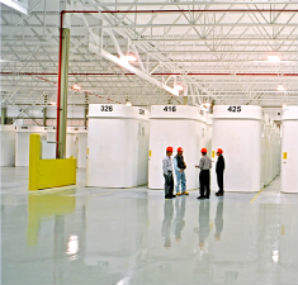Seventeen sites remain in the running to host a Canadian high-level waste repository, according to the country's Nuclear Waste Management Organization (NWMO).

Seventeen sites remain in the running to host a Canadian high-level waste repository, according to the country’s Nuclear Waste Management Organization (NWMO).
NWMO announced in November that it has completed the first phase of preliminary assessment in collaboration with eight of the 21 communities that expressed interest in hosting a deep geological repository and centre of expertise.
The communities of English River First Nation and Pinehouse in Saskatchewan, and Ear Falls and Wawa in Ontario, were not selected for more detailed study.
The remaining four communities: Creighton in Saskatchewan, and Ignace, Hornepayne and Schreiber in Ontario, were assessed as having "strong potential" to meet site selection requirements and have been identified for further study, NWMO said.
Thirteen other communities involved in the earlier stages of the site selection process also remain in the running.
In 2014, NWMO said it expects to complete phase 1 assessments for an additional 12 communities in Ontario: Arran-Elderslie, Blind River, Brockton, Elliot Lake, Huron-Kinloss, Manitouwadge, Nipigon, The North Shore, Saugeen Shores, South Bruce, Spanish and White River.
The second phase of preliminary studies will also begin in 2014. These will take place over a period of three to four years with a smaller number of communities that have "strong potential" to host the project. Work will include: preliminary geoscientific and environment investigations; preliminary safety assessments; more detailed social, economic and cultural studies; awareness building and a broadening of engagement to involve surrounding communities.
The process for selecting a site for the long-term management of Canada’s used nuclear fuel, known as Adaptive Phased Management, was initiated in May 2010. In September 2012, after prior notification, NWMO suspended the ‘expressions of interest phase’ of the site selections process. Preliminary assessments are the third of nine steps in the multi-year process, NWMO said.
By the end of the second phase of preliminary assessment, circa 2018, one or possibly two communities with strong potential to meet requirements to host the facility will be the focus of detailed site characterization (step 4). This step "may require an additional three to five years or more to complete," NWMO said.
Negotiations will then follow with potential host communities as to whether they are willing to proceed, and the proposed terms of the project (step 5). NWMO will select the preferred site, and ratify an agreement with the host community (step 6). Licensing (step 7) will be followed by construction of an underground demonstration facility (step 8) and then construction and operation of the repository (step 9), subject to licensing.
NWMO envisages a repository capacity of 3.6 million fuel bundles, an in-service date of 2035 and closure in 2160. To date Canadian nuclear power plants have produced "just over 2 million used fuel bundles," NWMO said.
Photo: Dry used nuclear fuel storage facility at OPG’s Western Waste Management Facility (Source: NWMO)
